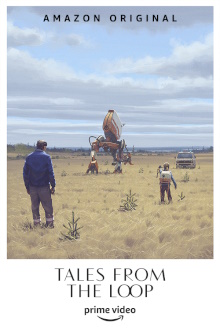I’m always interested in science-fiction shows with a unique premise so this series seemed like it would be a good fit. It’s an episodic collection of stories about a small town where strange things keep happening because of the research facility in it. Unfortunately this wasn’t at all what I thought it would be. It uses simple and predictable elements like time travel and alternate realities to tell emotional stories about the characters without caring about how the strange phenomena work at all. As my wife notes, it’s a very sentimental show that only uses the sci-fi phenomena as plot devices. It’s not bad at what it does but it really annoys me as a fan of science-fiction.
The town of Mercer hosts an underground physics laboratory that is colloquially known as the Loop. Many of the residents work there over the course of decades and at its heart is a large floating sphere of unknown origin with reality altering powers. The series is centered around one particular family in which the grandfather Russ is the founder of the Loop and the mother Loretta succeeds him as its director. There are also many robots scattered around the town, some of which are used to do work while others simply seem to wander around. Over the eight episodes, pretty much every member of the family and their friends encounter exotic phenomena that affects time, dimensions or involves robots in some way. There is no real worldbuilding and the stories are never about exploring the logical consequences of the existence of these phenomena. Instead they are human stories that emphasize emotional connections and the essential, unchanging nature of humanity.
Even without the exotic phenomena, Mercer is a rather strange place. It’s a company town in which almost everyone works at the Loop and seemingly has little contact with the outside world. Through multiple generations, little about the town seems to change and though the Loop is all about research, they never seem to discover anything new. The residents must be aware of the profusion of weird artifacts and potentially dangerous effects just lying about everywhere but they never so much as warn their children about it. In any kind of realistic scenario, the entire area would be cordoned off by the military with access strictly restricted. Every member of the family here has encountered something strange but they never discuss it with one another. While this show is superficially science-fiction, in fact it is the exact opposite and it evinces a total lack of curiosity about what is going on. Its format recalls the old Twilight Zone show but its ideas are less original and it’s much more sentimental, asking the audience to reflect on the relationships between the established characters across time and from multiple perspectives.
For anyone with any exposure to science-fiction, the stories are painfully predictable, especially the ones that are basically retreads of Rip Van Winkle. Still I have to concede that the episodes are reasonably well crafted. My favorite is probably the time stop story in which a couple uses the effect to enjoy their own private world. Yet there are also very simplistic ones such as the one expressing sympathy for a lonely monster. Perhaps what I like most about the show is its imagery which combines fantastical, sci-fi objects with a retro American small town aesthetic. No specific dates are mentioned, but the look of the town is no later than the 1980s and at times looks more like the 1950s. That’s not so surprising as the original inspiration was indeed an art book by the Swedish artist Simon Stålenhag. This explains why there’s no real worldbuilding and no consistency to its world at all. It’s just a mishmash of idea packed together. Having all of its stories be centered around a single family might make the audience feel more engaged but it also makes the setting feel less realistic.
I would never have added this to my list if I had known this is how it’s like. I found it boring and its cheap sentimentality felt unearned. My wife though enjoyed it well enough and considers this as a light introduction to science-fiction.
